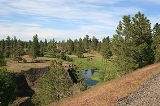
Turnbull National Wildlife Refuge
Encyclopedia

The Turnbull National Wildlife Refuge was established in 1937 by an Executive Order of President Franklin D. Roosevelt
Franklin D. Roosevelt
Franklin Delano Roosevelt , also known by his initials, FDR, was the 32nd President of the United States and a central figure in world events during the mid-20th century, leading the United States during a time of worldwide economic crisis and world war...
is located six miles (10 km) south of Cheney, Washington
Cheney, Washington
Cheney is a city in Spokane County, Washington, United States. The full time resident population was 10,590 as of 2010 census. Eastern Washington University is located in Cheney, and its population grows to approximately 17,600 people on a temporary basis when classes at Eastern Washington...
on the eastern edge of the Columbia Basin
Columbia Basin
The Columbia Basin, the drainage basin of the Columbia River, occupies a large area–about —of the Pacific Northwest region of North America. In common usage, the term often refers to a smaller area, generally the portion of the drainage basin that lies within eastern Washington.Usage of the term...
, in Spokane County in northeastern Washington. Turnbull NWR encompasses approximately 16000 acres (64.7 km²) of the Channeled Scablands
Channeled scablands
The Channeled Scablands are a unique geological erosion feature in the U.S. state of Washington. They were created by the cataclysmic Missoula Floods that swept periodically across eastern Washington and down the Columbia River Plateau during the Pleistocene epoch. Geologist J Harlen Bretz coined...
. The ecosystem that predominates the Turnbull is unique within the National Wildlife Refuge System and has characteristics that distinguish it from natural reserves worldwide. The powerful forces of volcanism, glaciation and the largest flood in geological history have combined to forge a distinct environment. The combination of basalt outcrops, channeled canyons and ponderosa pine forests infused in a diverse landscape of over 130 marshes, wetlands and lakes, create an environment of aesthetic beauty as well as high quality wildlife habitat. Refuge ecosystems represent an ecological transition between the dry, sagebrush dotted grasslands of the Columbia Basin and the timbered Selkirk and Bitteroot Mountain Ranges that rise up to the east. The 3036 acres (12.3 km²) of wetlands on Turnbull NWR represent some of the last quality breeding habitat available in eastern Washington for waterfowl, which have experienced tremendous population declines across North America due to loss and degradation of breeding, migration and wintering habitat.
Geology
The Refuge is situated within the Channeled ScablandsChanneled scablands
The Channeled Scablands are a unique geological erosion feature in the U.S. state of Washington. They were created by the cataclysmic Missoula Floods that swept periodically across eastern Washington and down the Columbia River Plateau during the Pleistocene epoch. Geologist J Harlen Bretz coined...
, an area formed 16,000 years ago by Missoula Floods
Missoula Floods
The Missoula Floods refer to the cataclysmic floods that swept periodically across eastern Washington and down the Columbia River Gorge at the end of the last ice age. The glacial flood events have been researched since the 1920s...
during the last ice age. The powerful forces of the volcanism which formed the Columbia Plateau
Columbia Plateau
The Columbia Plateau is a geologic and geographic region that lies across parts of the U.S. states of Washington, Oregon, and Idaho. It is a wide flood basalt plateau between the Cascade Range and the Rocky Mountains, cut through by the Columbia River...
, glaciation and a series of large floods combined to form an environment unique in many respects. The combination of scablands, basalt outcrops, channeled canyons, ponderosa pine
Ponderosa Pine
Pinus ponderosa, commonly known as the Ponderosa Pine, Bull Pine, Blackjack Pine, or Western Yellow Pine, is a widespread and variable pine native to western North America. It was first described by David Douglas in 1826, from eastern Washington near present-day Spokane...
forests and meadows provide a diverse landscape with over 130 marshes, wetlands and lakes. The area provides a high quality wildlife habitat in an ecosystems that represents an ecological transition between the dry, sagebrush dotted grasslands of the Columbia Basin
Columbia Basin
The Columbia Basin, the drainage basin of the Columbia River, occupies a large area–about —of the Pacific Northwest region of North America. In common usage, the term often refers to a smaller area, generally the portion of the drainage basin that lies within eastern Washington.Usage of the term...
up toward the timbered Selkirk
Selkirk Mountains
The Selkirk Mountains are a mountain range spanning the northern portion of the Idaho Panhandle, eastern Washington, and southeastern British Columbia. They begin at Mica Peak near Coeur d'Alene, Idaho and extend approximately 320 km north from the border. The range is bounded on its west,...
and Bitterroot Mountain Ranges
Bitterroot Mountains
The Northern and Central Bitterroot Range, collectively the Bitterroot Mountains, is the largest portion of the Bitterroot Range, part of the Rocky Mountains, located in the panhandle of Idaho and westernmost Montana in the Western United States...
that rise up to the east.
Wildlife and Habitat
The Turnbull National Wildlife Refuge was established to provide productive breeding and nesting grounds for migratory birds and other wildlife, and it encompasses approximately 16,000 acres (65 km²) of the Channeled Scablands. The ecosystem that predominates the Refuge is unique within the National Wildlife Refuge System and has characteristics that distinguish it from natural reserves worldwide. The 3,036 acres (12 km²) of wetlands on Turnbull NWR represent some of the last quality breeding habitat available in eastern Washington for waterfowl, which have experienced tremendous population declines across North America due to loss and degradation of breeding, migration and wintering habitat.External links
- Official site: Turnbull National Wildlife Refuge

